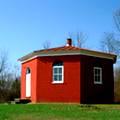- By Laetitia de Freslon
- Around Town
 Print
Print  The Eight Square Schoolhouse Celebrates 185 years of existence in Tompkins County and its Living History Program's 20th Birthday
The Eight Square Schoolhouse Celebrates 185 years of existence in Tompkins County and its Living History Program's 20th Birthday2012 marks the 20th anniversary of The History Center's Eight Square Schoolhouse Living History Program and the Schoolhouse's 185th year of existence in Tompkins County, as well as the re-opening of the building after major preservation work.
To celebrate these milestones in the history of the Eight Square Schoolhouse, The History Center is planning Family Day on Saturday, September 8th from 1 to 4pm at the Eight Square Schoolhouse (located on Upper Hanshaw Road, opposite from the Cayuga Radio Group). Activities on this day will include free live music, natural brick making, Purity ice cream, historic games and free visit of the building.
The Eight Square schoolhouse, built in 1827 by local carpenter Henry Balcom, is one of Tompkins County's finest local landmarks. It is the earliest school still existing in Tompkins County, and the only brick octagonal schoolhouse left standing in New York State. Used as the Town of Dryden District Number 5 school until 1941, when pupils began attending other schools in Dryden, the building was used for a brief period as a community activity center and as an occasional site for field trips. By the early 1950's the building had been declared surplus property, and it was in 1953 that ownership of the building and its lot were deeded to the DHS for the sum of $10. The building is on the National Register of Historic Places, and in 2000 it became an Official Project of Save America's Treasures.
Why Eight Sides? The philosophy of octagonal-shaped school buildings can be traced to a Quaker tradition brought over from the old country. The concept is based on the idea that an octagon shape was conducive to a better learning environment because the instructor could be placed in a prominent position within the space and be the focus of the students. It was also beneficial because the octagonal shape provided more square feet of inside space than either a rectangle or a square. Ventilation and lighting were also pertinent issues of the times, and an architectural structure with eight sides allowed for an opening in all sides of the building. The building's thick walls helped it to retain heat during the cold months, which also helped provide insulation against the heat in the warm weather.
The Eight Square Schoolhouse Campaign Preservation work on the building has included the replacement of the roof, reinforcement of the foundation, and a number of cosmetic improvements to the plaster, windows and doorway. The capital improvements will both improve the Schoolhouse's appearance and will ensure its structural integrity for years to come.
Location The Eight Square schoolhouse is located on Upper Hanshaw Road in Dryden, New York. Upper Hanshaw Road is approximately 1/4 mile East of the Tompkins County Regional Airport.
Begun in 1992 by Tompkins County Historian Gretchen Sachse, the intent of the History Center's Living History program was to present an accurate as possible 1892 program of studies to be used by the fourth graders of Tompkins County schools as it related to their Social Studies curriculum guidelines. Hired teachers were to be trained in imparting this curriculum, and they were also expected to become knowledgeable in local and national history of the era. Staying in character for the entire day also became an integral part of the overall experience, both for teachers and students.
Many people today wonder why 1892 was ultimately chosen by the first schoolhouse committee as the year to re-create for the students. 1892 was a pivotal year in United States history in terms of patriotism, education, and industrialization. The country was in the midst of celebrating the 400th anniversary of Columbus' landing in America. There was a also a nationwide effort in the 1890's to try and revamp the U.S. educational system, which had become lax and unstructured in recent years. The economic focus was shifting from an agrarian to an industrial society, and students needed education beyond the 3 R's.
In celebrating Columbus' discovery of the Americas, a number of everyday items were named in his honor, including the Columbian Pitcher Pump, the latest modern well pump introduced in 1892. A replica of this pump is in use on the school grounds today. Maps showing the Americas were fitted with special frames that simulated the scales on the back of a sea serpent - the terror that Columbus and his crew thought would befall them if they sailed off the edge of the earth! One of these original relief maps can be seen at the Eight Square Schoolhouse - and it is used in The History Center's Geography lessons. Children are also expected to know facts about Columbus' voyages, including the name of his three ships, and the island where he originally landed.
1892 was the first year that schools were expected to have their students save their pennies to help buy a flag, which cost about $25.00 - a hefty sum for those days! It was the first year that the Pledge of Allegiance was recited at the beginning of the school day - the original having no "under God" or "United States of America" in its version. Both phrases were added in the 1950's. A children's magazine called Youth's Companion was the first to publish the pledge, as well as the patriotic songs that children would begin to sing in schoolrooms. On the national scene, perhaps the most famous reminder of Columbus and his historical legacy was the 1892/1893 Chicago World's Fair Columbian Exposition, a mammoth extravaganza that still influences out culture into the 21st century.
v8i32



